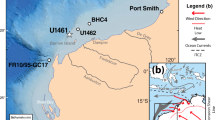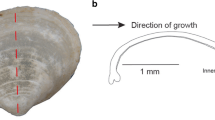Abstract
Aragonitic bivalves and abiotic aragonite are common in cold water Antarctic environments. Aragonitic bivalves have lower Mg, Sr, Fe and Mn and higher Na concentrations than those in abiotic polar aragonite. MgCO3 values in polar aragonitic bivalves and abiotic aragonite are related to pCO2. Sr values vary with aragonite types, seawater temperature and seawater content in the fluid precipitating aragonite. Abiotic polar aragonite contains much larger concentrations of Fe and Mn than those in aragonitic polar bivalves because abiotic aragonite formed subglacially below the zone of O2 minimum at very shallow water depths. Na values in aragonitic bivalves are indicative of both salinity and rates of crystal growth, whereas Na values in abiotic aragonite decrease with decreasing salinity. The concentrations of Mn, Na and Sr indicate that aragonitic bivalves formed faster than abiotic aragonite. The abiotic aragonite forms rapidly and precipitates significant amount in less than a year. This comparative study enables an understanding of cold water polar biotic and abiotic aragonites related to environment, water temperature, ice cover, pCO2 levels, redox potential, meltwater dilution, salinity and rate of carbonate formation. These aspects are essential in understanding modern and ancient glacial sedimentation and diagenesis.
Similar content being viewed by others
References
BUSENBERG, E. and PLUMMER, N.L., 1985, Kinetic and thermodynamic factors controlling the distribution of SO4 and Na in calcites and selected aragonites:Geochimica et Cosmochimica Acta, v. 56, p. 1837–1849.
BURTON, E.A. and WALTER, L.K., 1991, The effects of pCO2 and temperature on magnesium incorporation in calcite in seawater and MgCI2-CaCl2 solutions:Geochimica et Cosmochimica Acta, v. 55, p. 777–785.
CAREY, J.S., MOSLOW, T.F., and BARRIE, J.V., 1995. Origin and distribution of Holocene temperate carbonates, Hecate Strait, westem Canada continental shelf:Journal of Sedimentary Research, v. 65, p. 178–194.
CARPENTER, S. and LOHMANN, K.C., 1992, Sr/Mg ratios of modem marine calcite: Empirical indicators of ocean chemistry and precipitation rate:Geochimica et Cosmochimica Acta, v. 56, p. 1837–1849.
CHAVE, K.E., 1954, Aspects of the biogeochemistry of magnesium 2. Calcareous sediments and rocks.Journal of Geology, v. 62, p. 587–599.
DOMACK, E.W., 1988, Biogenic facies in the Antarctic glacimarine environment: Basis for a polar glacimarine summary:Paleogeography, Palaeoclimatology, Palaeoecology, v. 63, p. 353–372.
FERRIS, J.M. and BURTON, H.R., 1988, Annual cycle of heat content and mechanical stability of hypersaline deep lake, Vestfold Hills, Antarctica:Hydrobiologia, v. 165, p. 115–128.
FRIEDMAN, G.M., 1998, Rapidity of marine carbonate cementation — implications for carbonate diagenesis and sequence stratigraphy: perspective:Sedimentary Geology, v. 119, p. 1–4.
FUCHTBAUER, H. and HARDIE, L.A., 1976. Experimentally determined homogeneous distribution coefficients for precipitated magnesium calcite. application to marine carbonate cements: Geological Society of America Abstracts with Programs, v. 8, p. 877.
HARRIS, P.T., O’BRIEN, P.E., SEDWICK, P., and TRUSWELL, E.M., 1996, Late Quaternary history of sedimentation on the Mac. Robertson Shelf, East Antarctica: problems with14C-dating of marine sediment core:Papers and Proceedings Royal Society of Tasmnia, v. 130, p. 47–53.
LAND, L.S. and HOOPS, G.K., 1973. Sodium in carbonate sediments and rocks: a possible index to the salinity of diagenetic solutions:Journal of Sedimentary Petrology, v. 43, p. 614–617.
LEES, A., 1975, Possible influence of salinity and temperature on modern shelf carbonate sedimentation:Marine Geology, v. 19, p. 159–198.
LEES, A. and BULLER, A.T., 1972, Modem temperate-water and warm water shelf carbonate sediments contrasted:Marine Geology, v. 13, p. M67-M73.
LORENS, R.B., 1981, Sr, Cd, Mn and Co distribution coefficients in calcite precipitation rate:Geochimica et Cosmochimica Acta, v. 45, p. 553–561.
MORRISON, J.O. and BRAND, U., 1987, Geochemistry of Recent marine invertebrates:Geoscience Canada, v. 13, p. 237–254.
MORSE, J.W. and MacKENZIE, F.T., 1990, Geochemistry of Sedimentary Carbonates. Developments in Sedimentology 48, Elsevier, 707 p.
MUCCI, A., 1987, Influence of temperature on the composition of magnesian calcite overgrowths precipitated from seawater.Geochimica et Cosmochimica Acta, v. 51, p. 1977–1984.
MUCCI, A., 1988, Manganese uptake during calcite precipitation from seawater: Conditions leading to the formation of a pseudokutnahorite:Geochimica et Cosmochimica Acta, v. 52, p. 1859–1868.
MUCCI, A. and MORSE, J.W., 1983, The incorporation of Mg and Sr into calcite overgrowths: influences of growth rate and solution composition:Geochimica et Cosmochimica Acta, v. 47, p. 217–233.
NELSON, C.S., 1988, An introductory perspective on non-tropical shelf carbonates.In Nelson, C.S., ed., Non-tropical shelf carbonates-Modem and Ancient:Sedimentary Geology, v. 60, p. 3–12.
NELSON, C.S., KEANE, S.L., and HEAD, P.S., 1988, Non-tropical carbonate deposits on the modern New Zealand shelf:Sedimentary Geology, v. 60, v. 71–94.
PICKARD, J., ADAMSON, D., HARWOOD, D.M., MILLER, G.H., QUILTY, P.G., and DELL, R.K., 1984, Early Pliocene marine sediments in the Vestfold Hills, East Antarctica: Implication for coastline, ice sheet, and climate:South African Journal of Science, v. 82, p. 520–521.
PINGITORE, N.R., EASTMAN, M.P., SANDIDGE, M., ODEN, K., and FRFEIHA, B., 1998, The co-precipitation of Managanese (II) with calcite: an experimental study:Marine Chemistry, v. 25, p. 107–120.
RAO, C.P., 1981, Criteria for recognition of cold-water carbonate sedimentation: Berriedale Limestone (Lower Permian), Tasmania, Australia:Journal of Sedimentary Petrology, v. 51, p. 491–506.
RAO, C.P., 1993, Carbonate minerals, oxygen and carbon isotopes in modem temperate bryozoa, eastem Tasmania, Australia:Sedimentary Geology, v. 88, p. 123–135.
RAO, C.P., 1996, Modern Carbonates: tropical, temperate and polar-introduction to sedimentology and geochemistry, Carbonates, Hobart, 206 p.
RAO, C.P., 1997, A Colour Illustrated Guide to Sedimentary Textures: Cold, Cool, Warm and Hot — an introduction to the interpretation of depositional, diagenetic and hydrothermal temperatures. Carbonates, Hobart, 128 p.
RAO, C.P., 1998, Cold water polar abiotic aragonite elemental composition, East Antarctica:Sedimentary Geology (submitted).
RAO, C.P. and GREEN, D.C., 1982, Oxygen and carbon isotopes of Early Permian cold-water carbonates, Tasmania, Australia:Journal of Sedimentary Petrology, v. 52, p. 1111–1125.
RAO, C.P., AMINI, Z.Z., and FRANKLIN, D., 1995, Grain-size, biota, sedimentology and oxygen and carbon isotopes of sediments, Davies Station and Prydz Bay, Antarctica: evidence for occurrence and recession of shelfice:ANARE Research News, v. 94, p. 33–34.
RAO, C.P., AMINI, Z.Z., and FRANKLIN, D., 1996, Comparison between modem polar and temperate skeletal carbonate mineralogy and oxygen and carbon isotopes, Antarctica and Tasmania shelves.In Banks, M.R. and Brown, M.J., eds., Climatic succession and glacial history of the southern hemisphere over the last five million years.Papers and Proceedings of Royal Society of Tasmania, v. 130, p. 87–93.
RAO, C.P., GOODWIN, I.D., and GIBSON, J.A.E., 1998, Shelf, coastal and subglacial polar carbonates, East Antarctica:Carbonates and Evaporites, v. 13, p. 174–188.
WILSON, J.B., 1988, A model fortemporal changes in the faunal composition of shell gravels during a transgression on he continental shelf around British Isles:Sedimentary Geology, v. 60, p. 95–105.
Author information
Authors and Affiliations
Rights and permissions
About this article
Cite this article
Rao, C.P. Cold water polar aragonitic bivalve elemental composition, east Antarctica. Carbonates Evaporites 14, 56–63 (1999). https://doi.org/10.1007/BF03176148
Received:
Accepted:
Published:
Issue Date:
DOI: https://doi.org/10.1007/BF03176148




